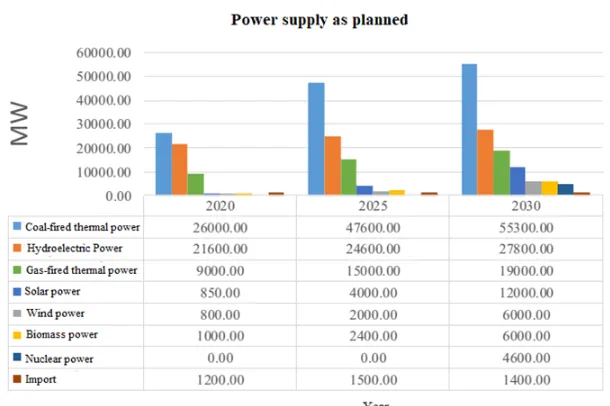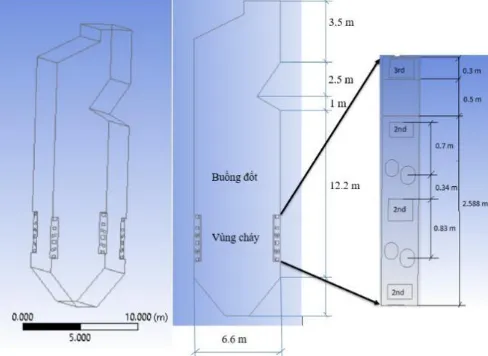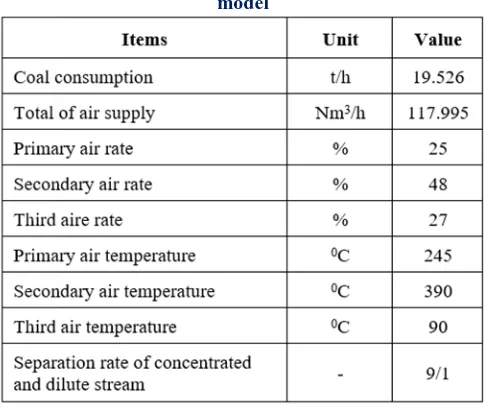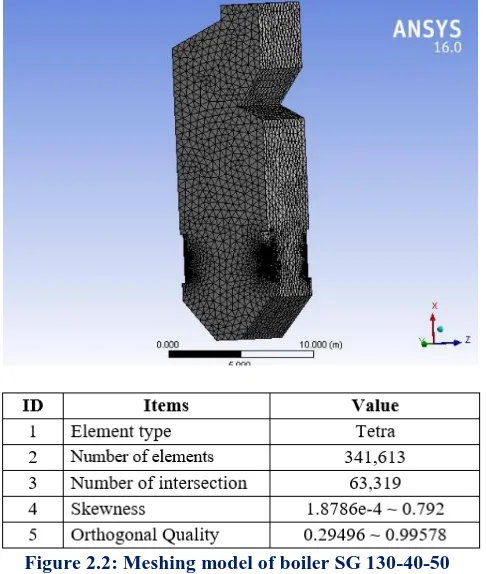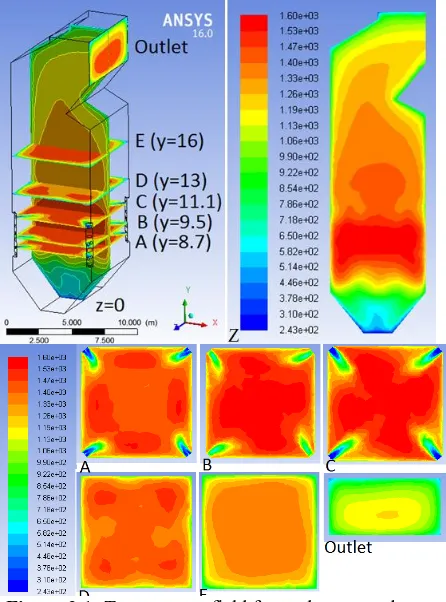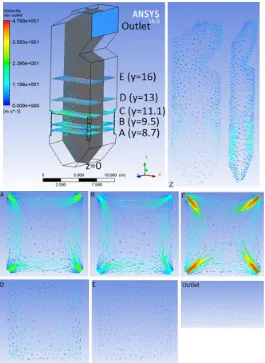ISSN (e): 2250-3021, ISSN (p): 2278-8719
Vol. 09, Issue 11, November. 2019, Series -II, PP 30-37
Application of Numerical Simulation to Analyze and Evaluate
Combustion Process, Heat Distribution and Coal Complete
Combustion Efficiency of Boiler in Thermal Power Plant
Huong Nguyen Viet
1, Dung Le Duc
21Institute of Energy Science - Vietnam Academy of Science and Technology 2Hanoi University of Science and Technology
Corresponding Author: Huong Nguyen Viet Received 07October 2019; Accepted 23October 2019
Abstract:
In Vietnam, coal-fired thermal power has been playing a important role in the national electricity supply. According to the master power plan number 7+, in 2016, the demand of power generation capacity is approximately two times higher than the annual GDP growth rate, and must ensure the efficient use of the domestic hard-to-burn anthracite coal and imported coal. The thermal power plants in Vietnam, especially the old power plants are facing frequent changes in the quality of coal supply from domestic and imported sources, thus the implementation of tests to check and optimize the operating parameters whenever there is a change in coal sources quality, before actual operation, is very important and necessary for the efficient and continuous operation of the plants. The application of numerical simulation technology, which helps to shorten the testing time and optimize operational parameters, greatly reduces annual costs for testing, and helps optimize design and testing with advantages thanks to the intuitive, clear and highly accurate evaluation results. Therefore, this study carried out the application of numerical simulation on CFD (Computational fluid dynamics) to analyze and evaluate coal burning process and heat distribution in SG 130-40-450 boiler with the important criteria for evaluating the efficiency of combustion process in the boiler of the thermal power plant: temperature field, velocity field, coal complete combustion efficiency.Keywords:
CFD, numerical simulation, coal combustion, boiler, thermal power plant.I.
INTRODUCTION
Figure 1.1: Planning of power supply in Viet Nam up to 2030
With the large share of the generation capacity of the thermal power plants in the national power supply, and the generation capacity increases rapidly year by year, and the fluctuations in coal quality, the efficient use of coal in the thermal power plants is of great significance in the operation of the national power system. Analysis and assessment of coal combustion and heat distribution in the boiler is an important step to build options to optimize the boiler operation to improve coal efficiency, reduce costs of fuel and save time. Due to implementation of traditional experimentation methods is very expensive, it takes a long time to build a physical model, the process of controlling and operating the combustion process is very complicated, but thanks to advancement of numerical technology, the computer helps to analyse and research the combustion process is much easier through the CFD combustion theory calculation tool, which helps reduce costs and save time.
As we all know, conducting experiments is very expensive and takes a lot of time, thus the authors have used CFD numerical simulation model to analyse and evaluate the efficiency of coal combustion and heat distribution inside the boiler. The results show the temperature field and other criteria of combustion to analyse and evaluate the efficiency of combustion process to build options of optimal operation for coal used in operation, in order to limit and reduce the adhesion of slag in the combustion chamber, or select the most optimal parameters to do experiments [3-6] with minimum cost and the shortest time.
CFD software is a powerful tool to simulate the coal powder combustion process in the boiler, assessing the combustion chamber structure to calibrate and optimize coal combustion process. In combustion industry and energy production industries, the CFD numerical simulation models mentioned in [2] has been widely applied. Simultaneously, there are also many scientific studies on the combustion of coal powder using CFD tools, especially including studies on the combustion process of coal powder of tangent injection nozzle boiler by T. Asotani et al., 2008. [6], ChoengRyul Choi and Chang Nyung Kim, 2008 [8], Zhao Feng Tian et al., 2009 [17], Cristiano V. da Silva et al., 2010 [9], studies of mixed effects coal to combustion in a boiler chamber, RI Backreedy et al., 2005 [16], Y.S. Shen et al., 2006 [15]. Other uses of CFD in the study of the formation of NOx in coal combustion were presented in B.R. Stanmore, 1999 [12], M. Xu et al., 2000 [13], Z.Q. Li et al., 2002 [7].
The purpose of this study is to do application of numerical simulation model to analyse and evaluate combustion process of coal, heat distribution and determine coal complete combustion efficiency of boiler SG-130-40-450 of NinhBinh thermal power plant in Vietnam.
II.
NUMERICAL SIMULATION OF COAL POWDER COMBUSTION PROCESS
2.1. Calculation domain and boundary conditions
Figure 2.1: Model of combustion chamber of boiler SG 130-40-50
and at once separate the hot smoke stream at the combustion centre and the fire chamber wall to give ability to control and help limit the phenomenon of slag in the fire chamber.
Table 2.1, table 2.2 and table 2.3 below are properties of coal and boundary conditions. Table 2.1: Technology composition and heat
value of coal
Table 2.2: Chemical composition of coal
Table 2.3: Boundary conditions for the simulation model
2.2. CFD model
2.2.1. Calculation model and numerical method
k-epsilon Realisable, the radiation model of Discrete Ordinate Method (DOM) and the gas phase reaction flow model of Eddy Dissipation used in all simulation cases. All models are stationary and ignore the influence of gravity. The movement of coal particles is calculated according to Lagan Gian formula [3,11]. The removal of volatile matter and coke burning occurs when coal particles are injected and mixed with the air stream in the combustion chamber [9]. The process of escaping volatiles is modelled by first degree single model and the rate of escaping and burning volatiles is described by Arrhenius [3,11,14]. The combustion between volatile matter and air is calculated by Eddy dissipation model. The two-step reaction mechanism is as follows:
Coal + aO
2
bCO + cH
2O
(1)
CO + ½ O
2
CO
2(2)
In which a, b, c are reaction factors, depending on the composition and properties of coal.The coke combustion process is calculated according to kinetics/diffusion-limited model. The surface reaction rate is calculated based on kinetics rate or diffusion rate [6,8,14]. Details of the models are presented in Fluent 16.0 User’s guide.
Figure 2.2 shows meshing model and meshing parameter of the simulation model
Figure 2.2: Meshing model of boiler SG 130-40-50 2.2.2. Solution process
The study uses a solution process to ensure the quick convergence of the solution, while ensuring the accuracy of the results [14], namely 5 steps as follows:
1. Solve the problem only with air stream without coal particle injection by starting the simulation calculation process with 300 loops for the unresponsive flow.
2. Initialize the reaction flow simulation of the problem by patching the temperature in the reaction zone and running 1 iteration step to ignite the flame.
3. Calculate the simulation process with 500 loops for reaction flow.
4. Activate the Discrete Ordinates radiation model and calculate the simulation with 500 iterations
III.
RESULTS AND DISCUSSION
3.1. Temperature fieldFigure 3.1 and table 3.1 below show the heat distribution results in the boiler.
Figure 3.1: Temperature field for each survey plane
Table 3.1: Details of temperature on each plane
Observing the simulation results of the above temperature field, we can see that according to the height of the boiler, the temperature has a quite clear stratification. The temperature between section A and section D has a high temperature and gradually decreases towards the top and bottom of the boiler.
The highest temperature is at the combustion chamber centre shown in C plane of Figure 3.1 and Table 3.1 above with the temperature is over 1600 0C. The minimum temperature of plane A and C has markedly low value because these are areas of locating burner nozzles and air inlets.
Average temperature increases with the height of the combustion chamber from the plane A to C due to increase of combustion intensity. When exiting the burning zone (Plane D to F), the temperature decreases due to radiation and convection heat exchange between the air stream and the combustion chamber wall.
The average temperature of flue gas before going out of the combustion chamber is 1054.73 0C higher than the value measured at the actual boiler of the plant in the same location is about 30 0C. Thus, theresults of the model are acceptable.
3.2. Velocity field
Figure 3.3: Velocity field for each survey plane (m/s)
The results show the highest velocity is at the burner nozzle, then gradual decrease of velocity due to diffusion and friction inside the boiler chamber, there are some local vortex phenomena a few locations. Thanks to the arrangement of the nozzles in a tangential direction that creates a vortex at the chamber center (combustion center) to increase the Coal burning efficiency when at here will form a fireball with very high temperatures. The size of the fireball will depend on the design to increase the efficiency of burning.
The velocity is nearly zero at the chamber wall, the velocity increases gradually when entering the combustion chamber center and reaches maximum value at area between the combustion chamber center and the wall, then decreases gradually as it enters the center.
3.3. Determination of complete combustion efficiency
Complete combustion efficiency is determined based on the efficiency of use of oxygen for combustion reactions, doing as following:
Determine the amount of oxygen needed for combustion:
According Table 2.3, coal consumption (B) is 19.526 ton/hour is equal to 5.424 kg/s According to [20][21][22]:
- The amount of oxygen needed for complete combustion is
𝑉𝑂02 = 1.866
𝐶𝑎𝑟
100+ 0.7 𝑆𝑎𝑟
100+ 5.6 𝐻𝑎𝑟
100− 𝑂𝑎𝑟
100𝑥1.428; ( 𝑚𝑡𝑐3
𝑘𝑔)
- The amount of oxygen needed to completely burn the amount of coal (B) is
𝑉𝑂2
0′ = 𝐵𝑥𝑉 𝑂2
0 = 5.424 𝑥 1.26217 = 6.84602; (𝑚𝑡𝑐 3
𝑠 )
- The density of oxygen in standard condition is ρ = 1.346 kg/m3
Combining with chemical properties of coal used in Table 2.2, result of calculation of the amount of oxygen needed to completely burn the amount of coal (B) is:
G0’O2 = V0’O2 x ρ = 9.21475 (kg/s)
Determine the amount of oxygen used for combustion from the simulation model The total of oxygen delivered to the model for the combustion:
GO2 = 9.22760 (kg/s)
The amount of oxygen does not participate in the combustion process obtained at the outlet of the simulation model:
GO2outlet = 0.76937 kg/s
Thus, the actual amount of oxygen involved in the combustion reactions are: GO2pu = GO2 - VO2outlet = 8.45823 (kg/s)
The complete combustion efficiency is determined based on based on the efficiency of use of oxygen for combustion reactions, thus, coal complete combustion efficiency is
Ƞ = Ƞ𝑂2=
𝐺𝑂2𝑝𝑢 𝐺𝑂20
=8.45823
9.21475= 91.79%
The coal complete combustion efficiency of 91.79 % is an acceptable efficiency, however this efficiency can be further improved by optimizing some parameters such as the ratio of primary air and secondary air to improve the coal complete combustion efficiency.
IV.
CONCLUSION
The study has applied the CFD numerical simulation model to analyze and evaluate temperature and velocity fields inside the boiler, use the results of models to determining the coal complete combustion efficiency of the boiler with high accuracy.
The simulation results show that the operating status of the SG 130-40-450 boiler with the current fuel is good, with the temperature and velocity field meet the technical requirements, and with a good combustion efficiency. The simulation results are in accordance with actual operating results at the thermal power plant with high accuracy. However, with analysis and evaluation based on simulation models show that the operation of the boiler can be even more optimized to increase more the coal complete combustion efficiency of current coal such as optimizing the ratio of primary air and secondary which the authors will do in next time.
The simulation results give us a visual view of the temperature and velocity field inside the boiler, which would be difficult and costly to implement on a real model. Application of numerical simulation model is a significant meaning to help optimizing the boiler design and operation parameters whenever there is a change in fuel or technology with the intuitive, clear and highly accurate evaluation results, and shortening the testing time and optimize operational parameters, greatly reduces annual costs for testing.
The results obtained from the study through the CFD numerical simulation will give orientation of the experimental process of testing coal, design or any technical improvement in the actual model which is operating at the plants.
ACKNOWLEDGE
International organization of Scientific Research
37 | Page
REFERENCES
[1]. Government Office, Revised Power Planning VII, Hanoi, 18.03.2016.
[2]. Philip J. Stopford, Recent applications of CFD modelling in the power generation and combustion industries, Elsevier, Applied Mathematical Modelling 26 (2002) 351 – 374
[3]. Rajesh Holkar, Dr. Omprakash. D. Hebbal, CFD Anlysis of Pulverised-Coal Combustion of Burner Used In Furnace with Different Radiation Models, Journal of Mechanical and Civil Engineering, Vol 5 (2013) 25-34
[4]. Ryoichi Kurose, Numerical Simulations of Pulverized Coal Combustion, KONA (Review) in press [5]. Efim Korytnyi, Roman Saveliev, Miron Perelman, Boris Chudnovsky, Ezra Bar-Ziv, Computational fluid
dynamic simulation of coal-fired utility boilers: An engineering tool, Fuel 88 (2009) 9-18.
[6]. T. Asotani, T. Yamashita, H. Tominaga, Y. Uesugi, Y. Itaya, S.Mori, Prediction of ignition behavior in a tangentially fired pulverized coal boiler using CFD, Fuel 87 (2008) 482-490.
[7]. Z.Q. Li, F.Wei, Y. Jin, Numerical simulation of pulverized coal combustion and NO formation, Chemical Engineering Science 58 (2003) 5161-5171.
[8]. Choeng Ryul Choi, Chang Nyung Kim, Numerical investigation on the flow, combustion and NOx emission characteristics in 500 MWe tangentially fuel pulverized coal boiler, Fuel 88 (2009) 1720-1731 [9]. Cristiano V. da Silva, Maria Luiza S. Indrusiak, Arthur B. Beskow, CFD Analysis of the Pulverized Coal
Combustion Processes in a 160 MWe Tangentially-Fired-Boiler of a Thermal Power Plant, J. of the Braz. Soc. of Mech. Sci. & Eng. Vol XXXII, No.4, 2010
[10]. M. Xu, J.L.T. Azevedo, M.G. Carvalho, Modelling of the combustion process and NOx emission in a utility boiler, Fuel 79 (2000) 1611-1619
[11]. Ryoichi Kurose, Hisao Makino and Akira Suzuki, Numerical analysis of pulverized coal combustion characteristics using advanced low-NOx burner, Fuel Chemistry Division Preprints 48(1) (2003), 308-309
[12]. [12] B.R. Stanmore, S.P. Visona, Prediction of NO emissions from a number of coal-fired power station boiler, Fuel Processing Technology 64 (2000) 25-46
[13]. Minghou Xu, Jianwei Yuan, Shifa Ding, Handing Cao, Simulation of the gas temperature deviation in large-scale tangential coal fired utility boilers, Comput. Methods Appl. Mech. Engrg. 155 (1998) 369-380 [14]. James E. MACPHEE, Mathieu SELLIER, Mark JERMY and Edilberto TADULAN, CFD Modelling of Pulverized coal Combustion in a rotary lime kiln, Seventh International Conference on CFD in the Minerals and Process Industries, 2009
[15]. Y.S. Shen, B.Y. Guo, P.Zulli, D. Maldonado, A.B. Yu, A three-dimentional CFD model for coal blends combustion: Model formation and validation, Fifth International Conference on CFD in the Process Industries, 2006
[16]. R.I. Backreedy, J.M. Jones, L.Ma, M. Pourkashanian, A. Williams, A. Arenillas, B. Arias, F. Rubiera, Prediction of unburned carbon and NOx in a tangentially fired power station using single coals and blends, Fuel 84 (2005) 2196-2203
[17]. Zhao Feng TIAN, Peter J. WITT, M. Phillip SCHWARZ and William YANG, Numerical modelling of brown coal combustion in a tangentially fired furnace, Seventh International Conference on CFD in the Minerals and Process Industries, 2009
[18]. Chungen Yin, On gas and particle radiation in pulverized fuel combustion furnaces, Applied Energy (2015)
[19]. A. Williams, R.Backreedy, R.Habib, J.M. Jones, M. Pourkashanian, Modelling coal combustion: the current.
[20]. Nguyen Si Mao, Boiler Episode 1, Science and Technics Publishing House, 2006. [21]. Nguyen Si Mao, Boiler Episode 2, Science and Technics Publishing House, 2006.
[22]. Nguyen Si Mao, Theory and Burning Equipment, Science and Technics Publishing House, 2002.
